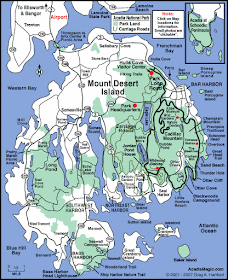Acadia was first established as
Sieur de Monts
National Monument in July 1916 by President Woodrow Wilson but then was
changed to Lafayette National Park in February 1919 when it became the
first national park east of the Mississippi. It was not until January
1929 that it officially was named Acadia National Park. The story we heard was that some ladies were going to donate more land, but didn't want to give anything to the French, and that's why it was changed to Acadia National Park. Apparently they did not know that Arcadia was a French colony to begin with. I couldn't resist putting in the map of MDI to give some perspective. The green is the park, and the dark black is the park loop road. The road is one-way along the southeast side of the island, but two way through the interior.
 |
| Sand Beach |
Maine is noted for its rocky coast, and this is the only sand beach to be found anywhere. Even though the water is really cold, tourists couldn't resist going to the beach. I bet they only got their toes wet then came right back out.
Here's where the one way roads prove to be a good idea. There are incredible views all along this coast, so you are allowed to park in the right lane of the road and walk along the crest. Occasionally there are smaller paths like the one we took to eat lunch with a view. In the height of the tourist season, they have to close the park road to traffic. What a way to spoil your vacation! They have shuttles then to take you around the park, but I'm sure the buses get caught in traffic jams too. My advice - if you go to Acadia, make it in early June!
 |
| Birch trail |
The first place we stopped was Sieur de Monts Spring. It has a springhouse and the Abbe Museum, which we didn't see, because we headed for the Nature Center immediately. The Wild Garden has more than 300 native species which are labeled to make identification easy. They are grouped in nine separate habitat areas, and we were enthralled! We learned that there are several different species of birch, and it was hard to distinguish them from the alder, and occasionally the aspen. I never did get a handle on the difference between the spruce and fir trees.
 |
| Yellow Lady's Slipper |
Maine's spring season is 6-8 weeks behind us in Kentucky, so many early wildflowers were still blooming. I gasped aloud when we walked past this enormous cluster of Yellow Lady's Slippers.
 |
| Bunchberry |
 |
| Bog Laurel |
 |
| Star Flower |
 |
| Columbine |
Wildflowers are like birds, only easier to photograph since they don't fly away. We were delighted to find familiar plants, but just as happy to identify something new. The Bunchberrys look like dogwood trees growing low to the ground, and blueberries come in three sizes of bushes - short, medium and tall. The little Star Flower grows everywhere, and the garden keepers don't even bother to label it. I've never seen a flower with seven petals on the blossom before! Hmm, the internet says that Star Flowers can be found in Kentucky. The blossoms resembling Mountain Laurel were in fact Bog Laurel.
 |
| Interrupted Fern |
Maine ferns are everywhere, and I always wished I could take a class about them. We recognized many of the larger ferns - Cinamon, Royal, Ostrich- but the Interrupted Fern was really unusual. It grew green fronds on the botton, but they turned brown with spores in the middle, then green again at the top. The smaller ferns were harder to distinguish.










No comments:
Post a Comment